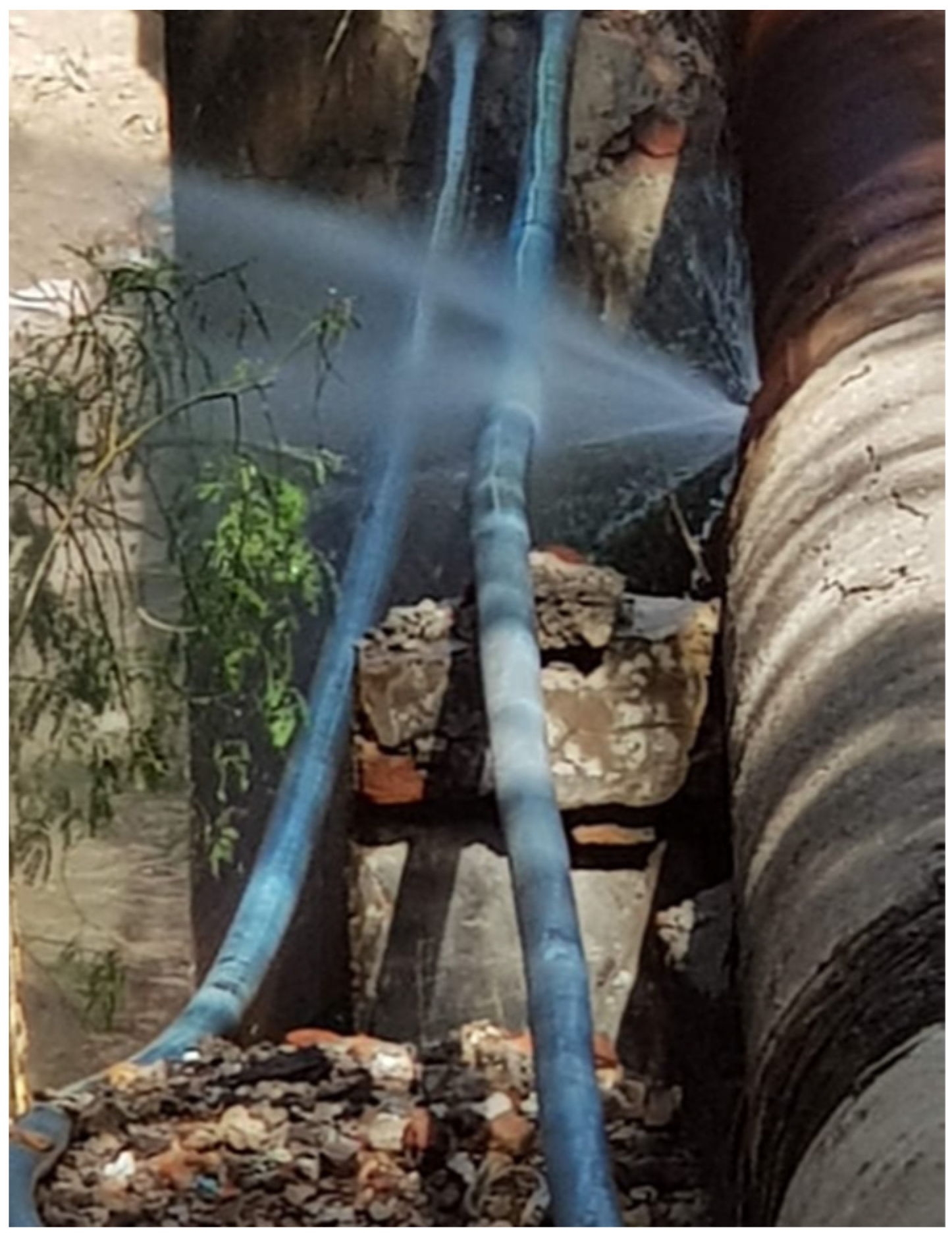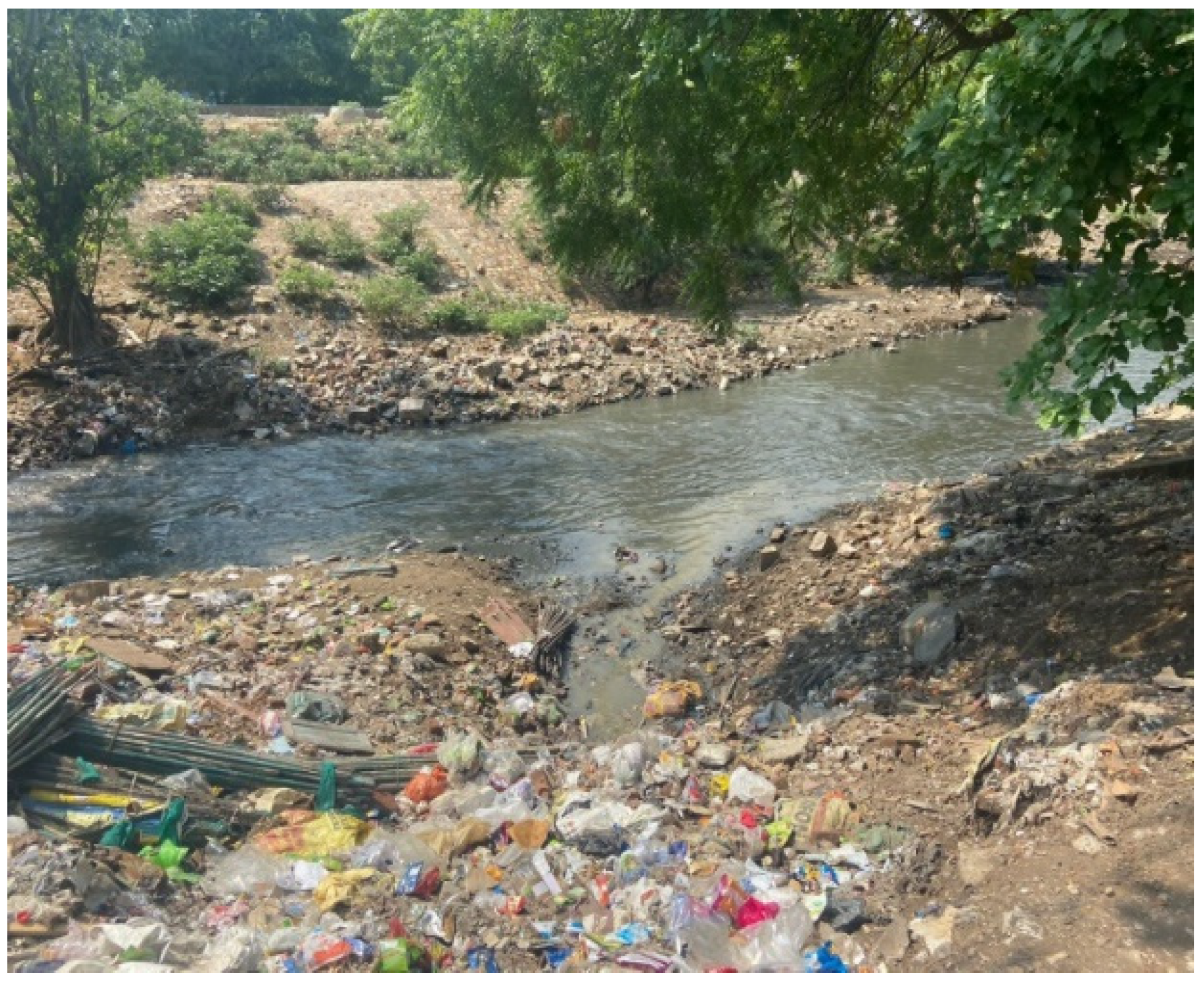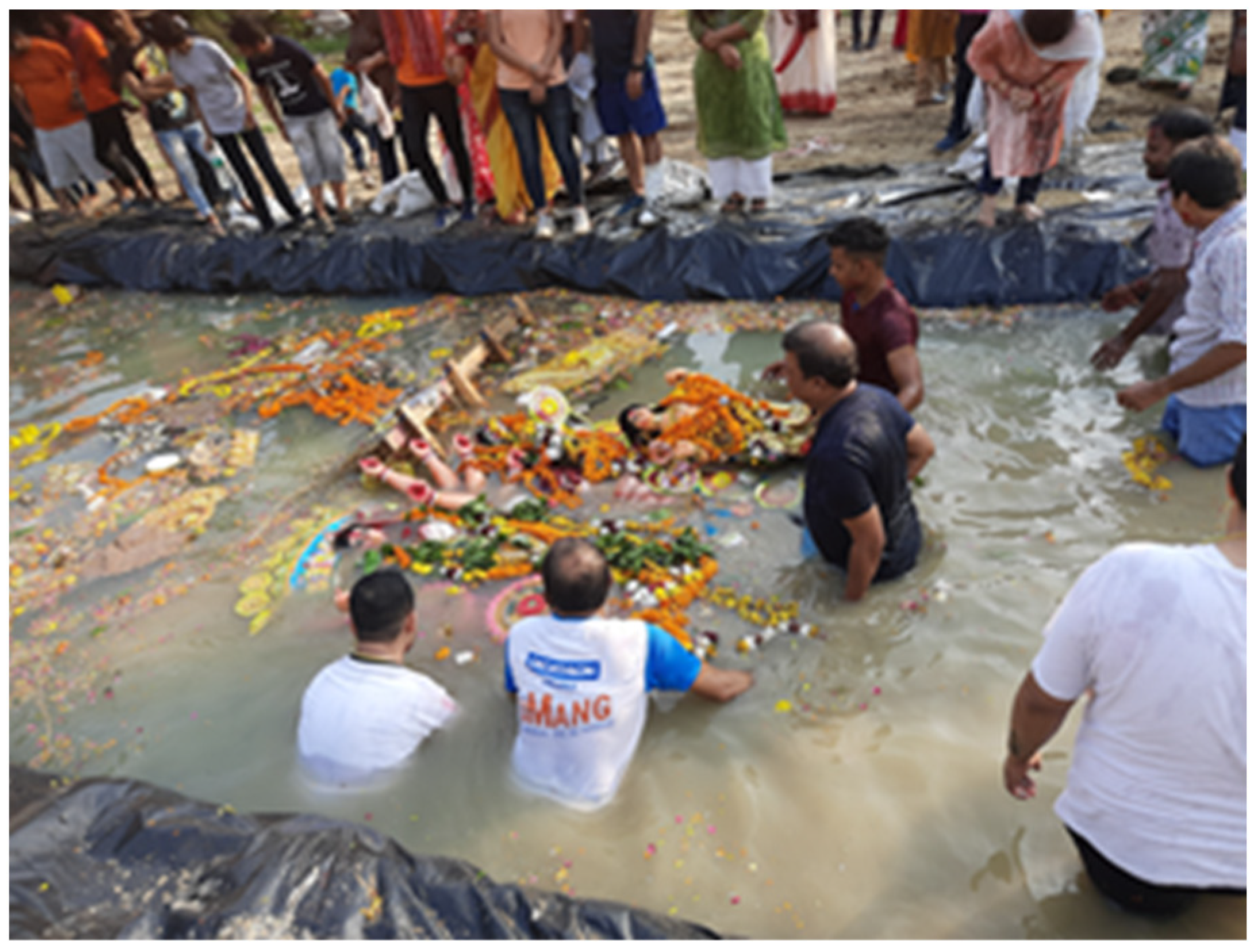Place of Social, Cultural, and Ecological Water Values for Promoting Water Security in Delhi, India
Abstract
1. Introduction
2. Diversity of Water Values: A Critical Exposition
2.1. Social Values of Water
2.2. Cultural Values of Water
2.3. Ecological Values of Water
2.4. Economic Values of Water
3. Dominance of the Economic Values Globally
Neo-Liberal Water Values in India and Delhi
4. Water Values in the NCT of Delhi
4.1. Sustainability and Precarity
“Recently what happened in 2019, DJB went to the Supreme Court of India regarding the amount of water that is required to serve Delhi. This water is required from Haryana. The SC told them to go to the Tribunal. They didn’t go. Now, when the politics changed, Haryana stopped supplies. So, the level of River Yamuna comes to 69 feet from 674 feet. When the case again reaches SC, they scold Delhi government for why they didn’t go to the Tribunal. Now Haryana has BJP government and Delhi has AAP. Both the parties don’t allow interfering in each other’s matters. People from Delhi were asking for help from officials, but we told them that the case is now in the hands of the Irrigation Minister of Haryana. Only when he allows, they can give water. In October, they shut the canal for the sake of cleaning it. We don’t have our water.”
4.2. Efficiency and Effectiveness
4.3. Exclusion, Inequality, and Inequity
4.4. Inequity and Inequality of Time and Space
4.5. Purity and Religiosity: Distressed Conditions of the River Yamuna
5. Discussion
6. Conclusions
Author Contributions
Funding
Data Availability Statement
Acknowledgments
Conflicts of Interest
References
- Rokeach, M. The Nature of Human Values; Free Press: New York, NY, USA, 1973. [Google Scholar]
- Shiva, V. Water Wars: Privatization, Pollution and Profit; Sound End Press: Cambridge, MA, USA, 2002. [Google Scholar]
- Bakker, K.J. An Uncooperative Commodity: Privatizing Water in England and Wales; Oxford University Press: Oxford, UK, 2004. [Google Scholar]
- Bakker, K. Neoliberal versus Postneoliberal Water: Geographies of Privatization and Resistance. Assoc. Am. Geogr. 2013, 103, 253–260. [Google Scholar] [CrossRef]
- Schouten, M.; Schwartz, K. Water as a political good: Implications for investments. Int. Environ. Agreem. Politics Law Econ. 2006, 6, 407–421. [Google Scholar] [CrossRef]
- Bayliss, K. The Financialization of Water. Rev. Radic. Political Econ. 2014, 46, 292–307. [Google Scholar] [CrossRef]
- Spronk, S.J. The Politics of Water Privatization in the Third World. Rev. Radic. Political Econ. 2007, 39, 126–131. [Google Scholar] [CrossRef]
- Bakker, K.J. A Political Ecology of Water Privatization. Stud. Political Econ. 2003, 70, 35–58. [Google Scholar] [CrossRef]
- Swyngedow, E. Social Power and the Urbanization of Water: Flows of Power; Oxford University Press: Oxford, UK, 2004. [Google Scholar]
- Kooy, M.; Walter, C.T. Towards A Situated Urban Political Ecology Analysis of Packaged Drinking Water Supply. Water 2019, 11, 225. [Google Scholar] [CrossRef]
- Powell, J.; Yurchenko, Y. The Evolution of Private Provision in Urban Drinking Water: New Geographies, Institutional Ambiguity and the Need for Political Economy. New Political Econ. 2020, 25, 91–106. [Google Scholar] [CrossRef]
- Walter, C.; Schmidt, M. Political ecological perspectives on an indicator-based urban water framework. Water Int. 2023, 48, 149–164. [Google Scholar] [CrossRef]
- Krause, F.; Strang, V. Thinking Relationships Through Water. Soc. Nat. Resour. 2016, 29, 633–638. [Google Scholar] [CrossRef]
- Boelens, R.; Escobar, A.; Bakker, K.; Hommes, L.; Swyngedouw, E.; Hogenboom, B.; Huijbens, E.H.; Jackson, S.; Vos, J.; Harris, L.M.; et al. Riverhood: Political ecologies of socio-nature commoning and translocal struggles for water justice. J. Peasant. Stud. 2023, 50, 1125–1156. [Google Scholar] [CrossRef]
- Heinrichs, D.H.; Rojas, R. Cultural Values in Water Management and Governance: Where do we stand? Water 2022, 14, 803. [Google Scholar] [CrossRef]
- Outlook India, IPL 2021: National Green Tribunal Directs Centre to Regulate Extraction of Groundwater for Cricket Matches. 2021. Available online: https://www.outlookindia.com/sports/sports-news-ipl-2021-national-green-tribunal-directs-centre-to-regulate-extraction-of-groundwater-news-380465 (accessed on 6 February 2023).
- Groenfeldt, D. Water Ethics: A Values Approach to Solving the Water Crisis, 2nd ed.; Routledge: Abingdon, Oxon; New York, NY, USA, 2019. [Google Scholar]
- Bauer, K.R.; Smith, A.Z. Value in water resources management: What is water worth? Water Int. 2007, 32, 877–888. [Google Scholar] [CrossRef]
- Haileslassie, A.; Ludi, E.; Roe, M.; Button, C. Water Values: Discourses and Perspective. In Clean Water and Sanitation; Filho, W.L., Azul, A.M., Brandli, L., Salvia, A.L., Wall, T., Eds.; Springer: Cham, Switzerland, 2020; pp. 1–10. [Google Scholar]
- Groenfeldt, D. Incorporating ethics into water decision-making. In Global Water Ethics; Routledge: Abingdon, UK; New York, NY, USA, 2017. [Google Scholar]
- Groenfeldt, D.; Schmidt, J.J. Ethics and Water Governance. Ecol. Soc. 2013, 18, 10. [Google Scholar] [CrossRef]
- High Level Panel on Water. Making Every Drop Count. United Nations, Department of Economic and Social Affairs, Sustainable Development. 2018. Available online: https://sdgs.un.org/documents/making-every-drop-count-high-level-panel-water-23223 (accessed on 18 November 2022).
- Pigmans, K.; Aldewereld, H.; Dignum, V.; Doorn, N. The Role of Value Deliberation to Improve Stakeholder Participation in Issues of Water Governance. Water Resour. Manag. 2019, 33, 4067–4085. [Google Scholar] [CrossRef]
- Delhi Development Authority. Draft Master Plan for Delhi-2041. 2021. Available online: https://dda.gov.in/master-plan-2041-draft (accessed on 8 December 2022).
- Delhi Jal Board. Economic Survey of Delhi 2022–2023. 2023. Available online: https://delhiplanning.delhi.gov.in/sites/default/files/Planning/ch._13_water_supply_and_sewerage.pdf (accessed on 10 July 2023).
- Schwartz, S.H. A Theory of Cultural Values and Some Implications for Work. Appl. Psychol. Int. Review. 1999, 48, 23–47. [Google Scholar] [CrossRef]
- Schwartz, S.H. Universals in the Content and Structure of Values: Theoretical Advances and Empirical Tests in 20 Countries. Adv. Exp. Soc. Psychol. 1992, 25, 1–65. [Google Scholar]
- Kluckhohn, C. Values and value-orientations in the theory of action: An exploration in definition and classification. In Toward a General Theory of Action; Parsons, T., Shils, E., Eds.; Harvard University Press: Cambridge, MA, USA; London, UK, 1951; pp. 388–733. [Google Scholar]
- Mintz, S. What are Values? Ethics Sage 2018. Available online: https://www.ethicssage.com/2018/08/what-are-values.html (accessed on 10 July 2022).
- Ncube, S.; Beevers, L.; Momblanch, A. Towards Intangible Freshwater Cultural Ecosystem Services: Informing Sustainable Water Resources Management. Water 2021, 13, 535. [Google Scholar] [CrossRef]
- Morgan, A.J.; Orr, S. The Value of Water: A Framework for Understanding Water Valuation, Risk and Stewardship. Int. Financ. Corp. 2015. Available online: https://d2ouvy59p0dg6k.cloudfront.net/downloads/the_value_of_water_discussion_draft_final_august_2015.pdf (accessed on 12 January 2023).
- Euzen, A.; Morehouse, B. Special issue introduction Water: What Values? Policy Soc. 2011, 30, 237–247. [Google Scholar] [CrossRef]
- Baviskar, A. What the Eye Does Not See: The Yamuna in the Imagination of Delhi. Econ. Political Wkly. 2011, 46, 45–53. [Google Scholar]
- UNESCO Bangkok and Regional Bureau for Education in Asia and the Pacific. Water Ethics and Water Resource Management; UNESCO: Bangkok, Thailand, 2011. [Google Scholar]
- Bogardi, J.J.; Dudgeon, D.; Lawford, R.; Flinkerbusch, E.; Mayn, A.; Pahl-Wostl, C.; Vielhauer, K.; Vörösmarty, C. Water security for a planet under pressure: Interconnected challenges of a changing world call for sustainable solutions. Curr. Opin. Environ. Sustain. 2012, 4, 35–43. [Google Scholar] [CrossRef]
- Schulz, C.; Ortega, J.M.; Glenk, K.; Ioris, A.A. The Value Base of Water Governance: A Multi-Disciplinary Perspective. Ecol. Econ. 2017, 131, 241–249. [Google Scholar] [CrossRef]
- Dublin Statement on Water and Sustainable Development 1992, International Conference on Water and the Environment. 1992. Available online: https://www.gdrc.org/uem/water/dublin-statement.html (accessed on 2 March 2023).
- Gibbons, D.C. The Economic Value of Water; Resources for the Future: Washington, DC, USA, 1987. [Google Scholar]
- Wilkinson, C.F. Values and Western Water: A History of the Dominant Ideas; Natural Resources Law Center, University of Colorado School of Law: Boulder, CO, USA, 1990. [Google Scholar]
- Linton, J. What Is Water? The History of a Modern Abstraction; UBC Press: Vancouver, BC, Canada, 2010. [Google Scholar]
- Budds, J.; McGranahan, G. Are the debates on water privatization missing the point? Experiences from Africa, Asia and Latin America. Environ. Urban. 2003, 15, 87–113. [Google Scholar] [CrossRef]
- Kallis, G.; Baggethun, E.G.; Zografos, C. To value or not to value? That is not the question. Ecol. Econ. 2013, 94, 97–105. [Google Scholar] [CrossRef]
- Matulis, B.S. The economic valuation of nature: A question of justice? Ecol. Econ. 2014, 104, 155–157. [Google Scholar] [CrossRef]
- Hall, R.P.; Koppen, B.V.; Houweling, E.V. The Human Right to Water: The Importance of Domestic and Productive Water Rights. Sci. Eng. Ethics 2013, 20, 849–868. [Google Scholar] [CrossRef]
- Arango, J.H.; Senent-De Frutos, J.A.; Molina, E.H. Murky waters: The impact of privatizing water use on environmental degradation and the exclusion of local communities in the Caribbean. Int. J. Water Resour. Dev. 2021, 38, 152–172. [Google Scholar]
- Asthana, V. Water Policy Processes in India; Routledge: Abingdon, Oxon; New York, NY, USA, 2009. [Google Scholar]
- Al-Weshah, R.A.; Saidan, M.N.; Al-Omari, A.S. Environmental Ethics as a Tool for Sustainable Water Resource Management; American Water Works Association: Portland, OR, USA, 2016; p. 7. [Google Scholar]
- Sara, J.J. Standing for the Value of Water. World Bank Blogs, 7 September 2017; p. 1. [Google Scholar]
- Delhi Jal Board, Draft Water Policy for Delhi. 2016. Available online: https://delhijalboard.delhi.gov.in/sites/default/files/Jalboard/universal-tab/water_policy_21112016_0.pdf (accessed on 11 July 2022).
- The Hindu. Delhi: A City Dependent on Its Neighbours for Water; The Hindu: New Delhi, India, 2021. [Google Scholar]
- Ministry of Jal Shakti, Government of India, Memorandum of Understanding 1994. 1995. Available online: https://jalshakti-dowr.gov.in/upper-yamuna-river-board/ (accessed on 10 August 2022).
- Hindustan Times. Summer Action Plan: DJB to Target 998MGD Peak Water Supply; Hindustan Times: New Delhi, India, 2022. [Google Scholar]
- Press Information Bureau. Status of Groundwater; Press Information Bureau: New Delhi, India, 2022. [Google Scholar]
- Central Ground Water Board. Master Plan for Artificial Recharge to Groundwater in India 2020; Ministry of Jal Shakti, Government of India: New Delhi, India, 2020. [Google Scholar]
- Central Ground Water Board (CGWB). Ground Water Year Book National Capital Territory, Delhi 2020–2021; Ministry of Jal Shakti, Government of India: New Delhi, India, 2021. [Google Scholar]
- Delhi Parks and Gardens Society, Department of Environment, Government of NCT of Delhi. 2018. Available online: https://dpgs.delhi.gov.in/sites/default/files/DPGS/generic_multiple_files/water_bodies_presentation.pdf (accessed on 4 January 2023).
- The Hindu. Delhi Agencies Seek to Delist 232 out of 1045 Waterbodies; The Hindu: New Delhi, India, 2023. [Google Scholar]
- Sharan, A. A river and the riverfront: Delhi’s Yamuna as an in-between space. City Cult. Soc. 2016, 7, 267–273. [Google Scholar] [CrossRef]
- Government of National Capital Territory of Delhi, The Delhi Jal Board Act 1998. 1998. Available online: https://delhijalboard.delhi.gov.in/sites/default/files/Jalboard/generic_multiple_files/delhi_jal_board_act_1998.pdf (accessed on 26 November 2022).
- Truelove, Y. Gray Zones: The Everyday Practices and Governance of Water beyond the Network. Ann. Am. Assoc. Geogr. 2019, 109, 1758–1774. [Google Scholar] [CrossRef]
- Truelove, Y. Negotiating states of water: Producing illegibility, bureaucratic arbitrariness, and distributive injustices in Delhi. Environ. Plan. D Soc. Space 2018, 36, 949–967. [Google Scholar] [CrossRef]
- Schindler, S.; Sharma, S. Delhi–Mumbai Industrial Corridor: Economic and Environmental Consequences. Econ. Political Wkly. 2017, 52, 12–16. [Google Scholar]
- Truelove, Y. Who is the state? Infrastructural power and everyday water governance in Delhi. Environ. Plan. C Politics Space 2021, 39, 282–299. [Google Scholar] [CrossRef]
- Truelove, Y. Incongruent Waterworlds: Situating the Everyday Practices and Power of Water in Delhi. South Asia Multidiscip. Acad. J. 2016. [Google Scholar] [CrossRef]
- Ranganathan, M. Mafias’ in the Waterscape: Urban Informality and Everyday Public Authority in Bangalore. Water Altern. 2014, 7, 89–105. [Google Scholar]
- Birkinshaw, M. Water Mafia’ politics and unruly informality in Delhi’s unauthorised colonies. In Water, Creativity and Meaning: Multidisciplinary Understandings of Human-Water Relationships; Roberts, L., Phillips, K., Eds.; Routledge: Abingdon, Oxon; New York, NY, USA, 2018; pp. 189–203. [Google Scholar]
- Rai, S.C. Water Management for a Megacity: National Capital Territory of Delhi. Water Resour. Manag. 2011, 25, 2267–2278. [Google Scholar] [CrossRef]
- Kumar, A.; Singh, N.; Cooper, S.; Mdee, A.; Singhal, S. Infrastructural Violence: Five Axes of Inequities in Water Supply in Delhi, India. Front. Water 2021. [Google Scholar] [CrossRef]
- Sheikh, S.; Sharma, S.; Banda, S. The Delhi Jal Board: Seeing beyond the Planned Centre for Policy Research, New Delhi. 2015. p. Working Paper. Available online: https://cprindia.org/briefsreports/the-delhi-jal-board-djb-seeing-beyond-the-planned/ (accessed on 19 September 2022).
- Jain, S.K.; Kumar, P. Environmental flows in India: Towards sustainable water management. Hydrol. Sci. J. 2014, 59, 751–769. [Google Scholar] [CrossRef]
- Yamuna Monitoring Committee. 29 June 2020. Available online: https://greentribunal.gov.in/sites/default/files/news_updates/Final%20Report%20by%20Yamuna%20Monitoring%20Committee%20in%20OA%20No.%2006%20of%202012.pdf (accessed on 26 November 2022).
- Delhi Pollution Control Committee. Progress in Rejuvenation of River Yamuna. October 2022. Available online: https://www.dpcc.delhigovt.nic.in//uploads/pdf/Progress-Rejuvenation%20of%20River%20Yamuna-%20Oct%202022.pdf (accessed on 26 November 2022).
- Delhi Pollution Control Committee. Impact of Idol Immersion on the Water Quality of River Yamuna, Delhi; Government of National Capital Territory of Delhi: New Delhi, India, 2019.
- Central Pollution Control Board. Revised Guidelines for Idol Immersion; Central Pollution Control Board: Delhi, India, 2020. [Google Scholar]
- Delhi Pollution Control Committee. Direction dated 13-10-2021 u/s 33 A of the Water (Prevention and Control of Pollution) Act, 1974 read along with Hon’ble National Green Tribunal orders for the immersion of idols on the festive occasion of Durga Pooja etc., Delhi; Government of National Capital Territory of Delhi: New Delhi, India, 2021. Available online: https://www.dpcc.delhigovt.nic.in//uploads/pdf/Directions13-10-2021pdf-ce01e274fd785e549bf3f72363e0b2ec.pdf (accessed on 26 November 2022).
- United Nations-Water. The United Nations World Water Development Report 2021: Valuing Water; UNESCO: Paris, France, 2021. [Google Scholar]
- United Nations-Water. World Water Day 2021 Toolkit. 2021. Available online: https://www.unwater.org/news/un-world-water-development-report-2021-%E2%80%98valuing-water%E2%80%99 (accessed on 19 August 2022).
- Truelove, Y. (Re-)Conceptualizing water inequality in Delhi, India through a feminist political ecology framework. Geoforum 2011, 42, 143–152. [Google Scholar] [CrossRef]






Disclaimer/Publisher’s Note: The statements, opinions and data contained in all publications are solely those of the individual author(s) and contributor(s) and not of MDPI and/or the editor(s). MDPI and/or the editor(s) disclaim responsibility for any injury to people or property resulting from any ideas, methods, instructions or products referred to in the content. |
© 2024 by the authors. Licensee MDPI, Basel, Switzerland. This article is an open access article distributed under the terms and conditions of the Creative Commons Attribution (CC BY) license (https://creativecommons.org/licenses/by/4.0/).
Share and Cite
Kumar, A.; Biswas, R.; Modi, R.; Button, C. Place of Social, Cultural, and Ecological Water Values for Promoting Water Security in Delhi, India. Water 2024, 16, 662. https://doi.org/10.3390/w16050662
Kumar A, Biswas R, Modi R, Button C. Place of Social, Cultural, and Ecological Water Values for Promoting Water Security in Delhi, India. Water. 2024; 16(5):662. https://doi.org/10.3390/w16050662
Chicago/Turabian StyleKumar, Ashok, Rabidyuti Biswas, Radhika Modi, and Cat Button. 2024. "Place of Social, Cultural, and Ecological Water Values for Promoting Water Security in Delhi, India" Water 16, no. 5: 662. https://doi.org/10.3390/w16050662
APA StyleKumar, A., Biswas, R., Modi, R., & Button, C. (2024). Place of Social, Cultural, and Ecological Water Values for Promoting Water Security in Delhi, India. Water, 16(5), 662. https://doi.org/10.3390/w16050662





